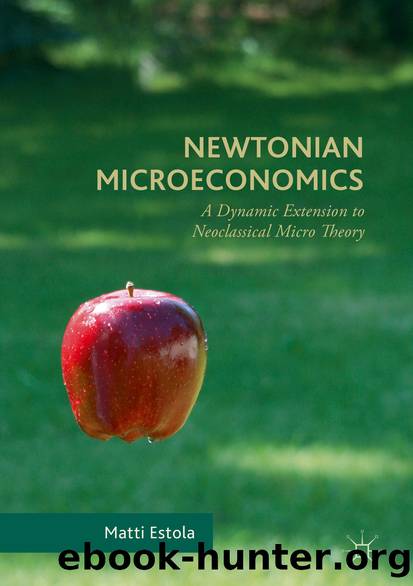Newtonian Microeconomics by Matti Estola

Author:Matti Estola
Language: eng
Format: epub
Publisher: Springer International Publishing, Cham
5.1.1 Why Do Different Market Situations Exist?
A homogeneous product produced by different firms, increasing returns to scale in production, and a relatively small market (a small number of customers and/or a small turnover in the industry) together mean that one big firm can produce the aggregate production of the industry with mass production methods at smaller unit costs than various small firms could do. In this kind of a situation, one firm can conquer the market over time by price competition. The monopolization of an industry due to increasing returns to scale in production is called a natural monopoly. If a monopolized industry is relatively small, it does not attract new firms. For these reasons, the monopoly firm in the industry can price its product in the limits the prices of imperfect substitute goods set for it, and the profitability of the monopoly firm does not attract new firms in the industry.
Some industries can be monopolized also due to social reasons. Such are: (1) The product is a public good; (2) Society likes to control the production of the good for political reasons, for example, nuclear power, education, or health care; (3) The good is important for the functioning of the state, like postal services or energy and water supply.
§: A ‘pure’ public good is such that if one consumer buys it, other consumers get it simultaneously at no charge.
The above means that in consuming a pure public good, ‘intimacy’ is lacking. Pure public goods are, for example, public defence, police, and fire protection. The services of state-owned research institutes are also usually publicly available, and thus they are public goods. When these goods have been produced, every inhabitant can enjoy their services and access cannot be denied from any individuals. For this reason, consumers are not willing to buy pure public goods, and private firms are not interested in producing such goods because no person likes to buy them for himself. The only way to finance the production of pure public goods is to use tax money.
Some goods can be partly public and partly market goods. For example, most parks and sport fields in cities are public goods. Even though every citizen can freely use these goods, people are in different position with respect to the services produced by them. Those living at the opposite side of the city must travel to enjoy these services, and in this way they have to pay for these services. Similar examples are public entertainment areas that benefit most those people living next to them.
Increasing returns to scale in production may define a minimum scale of production after which unit costs do not remarkably decrease any further. This together with a relatively small market may lead to an oligopoly situation.
§: Oligopoly is a market situation where a few relatively large firms produce a roughly homogeneous good with increasing returns to scale in production (see Sect. 5.5).
In oligopoly, small firms cannot manage in cost competition, and the size of the market does not allow profitable operation of many medium-size firms.
Download
This site does not store any files on its server. We only index and link to content provided by other sites. Please contact the content providers to delete copyright contents if any and email us, we'll remove relevant links or contents immediately.
International Integration of the Brazilian Economy by Elias C. Grivoyannis(86607)
The Radium Girls by Kate Moore(11873)
Turbulence by E. J. Noyes(7901)
Nudge - Improving Decisions about Health, Wealth, and Happiness by Thaler Sunstein(7469)
The Black Swan by Nassim Nicholas Taleb(6954)
Rich Dad Poor Dad by Robert T. Kiyosaki(6324)
Pioneering Portfolio Management by David F. Swensen(6175)
Man-made Catastrophes and Risk Information Concealment by Dmitry Chernov & Didier Sornette(5883)
Zero to One by Peter Thiel(5643)
Secrecy World by Jake Bernstein(4599)
Millionaire: The Philanderer, Gambler, and Duelist Who Invented Modern Finance by Janet Gleeson(4306)
Skin in the Game by Nassim Nicholas Taleb(4128)
The Age of Surveillance Capitalism by Shoshana Zuboff(4126)
The Money Culture by Michael Lewis(4033)
Bullshit Jobs by David Graeber(4001)
Skin in the Game: Hidden Asymmetries in Daily Life by Nassim Nicholas Taleb(3873)
The Dhandho Investor by Mohnish Pabrai(3642)
The Wisdom of Finance by Mihir Desai(3612)
Blockchain Basics by Daniel Drescher(3435)
